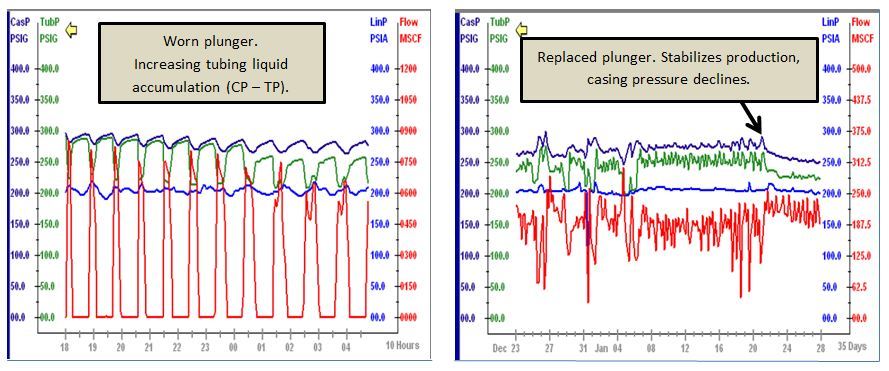When should I replace a plunger?
9When should I replace a plunger? The easy answer is before production declines. The practical answer can be a bit more involved.
Plungers for 2 3/8” tubing are roughly 12” to 18” long and weigh around 6-8 lbs. These machined cylindrical objects can fall and rise at over 1,000 feet per minute, covering 8,000 feet in less than 8 minutes. During its rise to the surface and fall to the bottom of the well, the OD of the plunger encounters the tubing walls, sand/water slurries, scale, paraffin, tubing joints and other unfriendly elements abrading the plunger’s surface. A continuous flow plunger cycling 50 times a day in a 8,000 feet deep well travels over 150 miles a day, 4,500 miles a month, 54,000 miles a year. Over time, the plunger OD wears and efficiency declines, resulting in slower plunger cycles and tubing liquid accumulation. Self-adjusting controllers targeting a preset rise velocity adjust for plunger wear by increasing the wells close time or decreasing the open time. Both adjustments increase the plunger velocity on a single cycle, yet production still declines due to less efficient cycles. Additionally, it is likely the well will operate at a higher flowing bottom-hole pressure to surface the plunger, which also reduces production.
Operators currently use a variety of methods to define when to replace a plunger. One supplier recommends replacing solid and flow thru plungers when the outer diameter diminishes by 0.020” for 2 3/8” and 2 7/8” plungers. This practice requires inspecting plungers on a periodic basis using a Go No-Go gauge or calipers. In practice, a stronger well may show no production decline at 0.020” wear while a weak well may show marked production decline prior to this point.
Some in-house optimizers observe production decline on a production chart (See Fig 1) to identify worn plungers. Others correlate production decline attributed to plunger wear to a defined number of cycles for each specific well and plunger. A disciplined plan is required to establish allowable plunger runs for each well.
Yet when implemented, this is the most effective approach, reducing opportunity for errors and limiting down time. A controller that notifies operators to replace worn plunger is a helpful tool! Replacing plungers in wells prior to production decline is a small price to pay relative to the alternative high cost of lost production (See Fig 2) and/or swabbing.
Fig 1. Worn plunger effect on production

Fig 2. Weekly lost revenue when well is not producing
